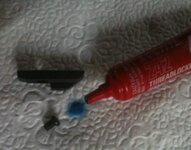Bronze Supporter
- Messages
- 6,750
- Reactions
- 21,513
Yeah, I overdid it.
I put too much Loctite 242 Threadlocker on a screw holding a loose front sight on my pistol. It's the blue Loctite we're supposed to be able to work with again later. Right?
Not so much. Went to replace the sight tonight and didn't expect to rip the tips off 2 screwdrivers. The screw remains defiantly frozen where I put it 2 weeks ago. I'm afraid to try more and booger it up.
Heat? Solvent? Acetone? Face paint, chanting in tongues, dancing around a fire and rattling chicken bones?
Wow!
I put too much Loctite 242 Threadlocker on a screw holding a loose front sight on my pistol. It's the blue Loctite we're supposed to be able to work with again later. Right?
Not so much. Went to replace the sight tonight and didn't expect to rip the tips off 2 screwdrivers. The screw remains defiantly frozen where I put it 2 weeks ago. I'm afraid to try more and booger it up.
Heat? Solvent? Acetone? Face paint, chanting in tongues, dancing around a fire and rattling chicken bones?
Wow!












